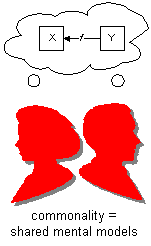| EDUCE Overview | Copyright 2009 Nikolas S. Boyd. All rights reserved. |
Create and share a common understanding among solution development stakeholders.

Software solutions can improve the quality of our lives, our business activities, and our business decisions. However, creating useful and usable software solutions requires effective communication among the solution stakeholders. So, creating a shared understanding of business policies, problems, and practices is the primary challenge facing a software development team. The degree to which all the various stakeholders share their (sometimes diverse) understandings, viewpoints, and needs affects their conceptual commonality.
In order to communicate and collaborate effectively, stakeholders must share a common understanding of the problems they are trying to solve (or resolve). Without a common vocabulary and shared conceptual models of a business opportunity and its attendant problem(s), the effectiveness of a software development team and the likelihood that the developed solution will achieve its intended ends are substantially reduced (if not utterly doomed).
Use conceptual commonality when
|
commonality: to the extent that people |
Discussions of business problems and opportunities often center on the situations that present themselves in a business: information that needs to be collected and shared, business activities that need to be improved, business policies that need to be enforced. Such discussions include statements that express vision, mission, values, viewpoints, interests, wants, needs, goals, conditions, situations, alternatives, options, requirements, roles, relationships, responsibilities, collaborations, events, qualities, quantities, and measures.
How can we ensure that business policies, problems, and practices are not merely understandable, but actually understood by all stakeholders? Using an ubiquitous language fosters commonality. Discussing, capturing, crunching, and reviewing knowledge manufactures commonality. To this end, a comprehensive, published domain vocabulary serves as a natural repository for business domain and solution requirements knowledge.
Natural conceptual models offer an effective means for producing domain vocabularies. Natural conceptual models are based on natural language, but with a restricted, simplified grammar, which is in turn based on a nuclear sentence. Each nuclear sentence focuses on the clear expression of a single idea using a normal form for clauses. The normal form gives sentences a consistently simple structure. This consistency and simplicity make ideas more readily sharable and comparable.
You can simplify the statements of stakeholders using the normal form and thereby produce statements that have a consistent structure. Participating analyst(s) can then assemble the normalized statements and publish them in a comprehensive domain vocabulary. The various stakeholders then review, validate, and assimilate the published domain vocabulary. Participating analyst(s) can also categorize the statements in a domain vocabulary, identifying which are policy statements, problem descriptions, and usage descriptions.